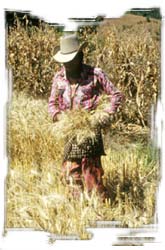CIMMYT E-News, vol 3 no. 7, July 2006
 A USAID-funded study by Williams College economist Douglas Gollin shows that modern maize and wheat varieties not only increase maximum yields in developing countries, but add hundreds of millions of dollars each year to farmers’ incomes by guaranteeing more reliable yields than traditional varieties.
A USAID-funded study by Williams College economist Douglas Gollin shows that modern maize and wheat varieties not only increase maximum yields in developing countries, but add hundreds of millions of dollars each year to farmers’ incomes by guaranteeing more reliable yields than traditional varieties.
Modern crop varieties developed through scientific crop breeding clearly produce higher yields than farmers’ traditional varieties. But critics have long maintained that, in developing countries, yields of modern varieties vary more from season to season than the traditional varieties, thereby exposing producers and consumers to greater risk.
Gollin’s study analyzed changes in national-level yield stability for wheat and maize across developing countries and related them directly to the diffusion of modern varieties. “The outcomes strongly suggest that, over the past 40 years, there has actually been a decline in the relative variability of grain yields—that is, the absolute magnitude of deviations from the yield trend—for both wheat and, to a lesser extent, for maize in developing countries,” says Gollin. “This reduction in variability is statistically associated with the spread of modern cultivars, even after controlling for expanded use of irrigation and other inputs.”
The value to farmers of reduced risk
Valuing these reductions in yield variability requires assumptions about society’s willingness to trade off risk against return. Using a standard analytic framework, the study finds that the reductions in variability are as valuable as small increases in average yield. Assuming a moderate level of risk aversion on farmers’ part and taking estimates for the magnitude of reductions in yield variability, the results suggest that the reductions in yield variability due to modern varieties are worth about 0.3% of annual production in the case of wheat and 0.8% of production in the case of maize. These appear to be small effects, but the sheer scale of wheat and maize production in the developing world means that the benefits from improved yield stability are large in absolute terms. At appropriate world prices, the benefits are about US$143 million for wheat and about US$149 million for maize, on an annual and recurring basis.
The study drew on country-level data for the diffusion of modern wheat and maize varieties compiled by Robert Evenson of Yale University, as well as aggregate data on production and yields from FAOSTAT, the global food information database of the Food and Agriculture Organization of the United Nations. The analysis also made novel use of a mathematical tool called the Hodrick-Prescott filter to disentangle changes in long term trends from annual fluctuations. The filter is most often used in macroeconomics.
According to Gollin, the benefits are not attributable to any particular research theme or program. “They reflect longstanding efforts in breeding for disease and pest resistance, drought tolerance, and improved cropping systems, to name a few,” he says. “By reducing the fluctuations in maize and wheat grain yields, scientists have played a vital role in making modern crop technology attractive, accessible, and beneficial to farmers and consumers around the globe.”
For more information contact John Dixon (j.dixon@cgiar.org)